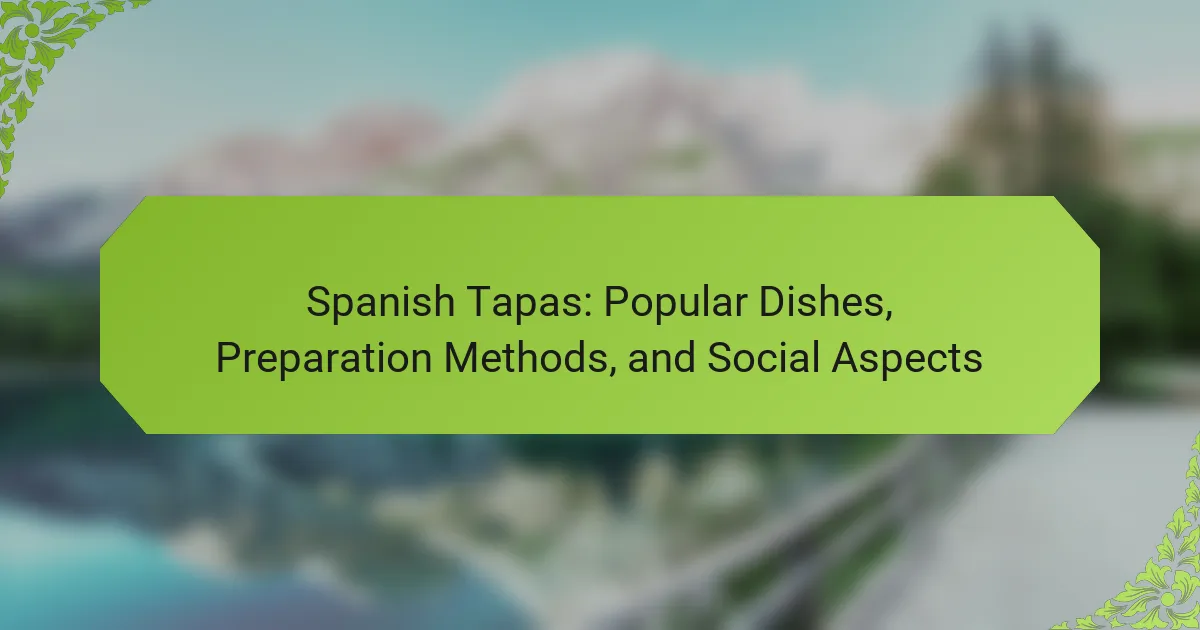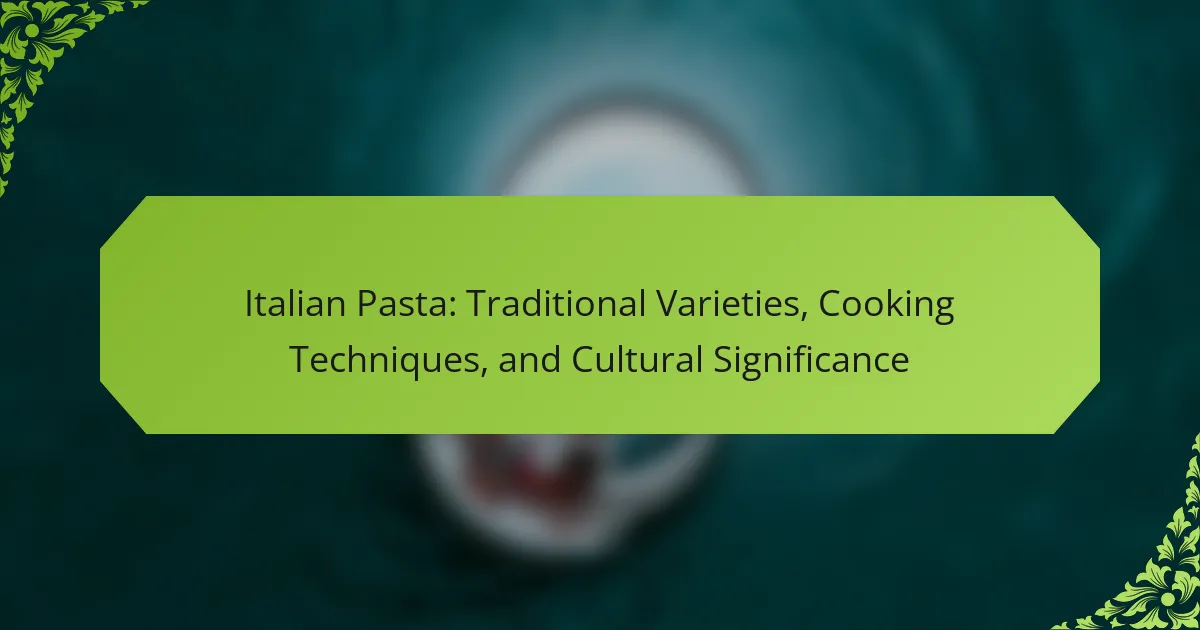Spanish tapas offer a delightful way to experience Spain’s culinary diversity while fostering social interaction. This article explores popular dishes like patatas bravas and jamón ibérico, various preparation methods that highlight regional flavors, and the communal dining aspects that make tapas a staple in Spanish culture. Additionally, we will discuss ideal beverage pairings and common mistakes to avoid for an authentic tapas experience.

What are the most popular Spanish tapas dishes?
The most popular Spanish tapas dishes include patatas bravas, jamón ibérico, and gambas al ajillo. These dishes showcase Spain’s rich culinary tradition.
Patatas bravas consist of fried potatoes served with a spicy tomato sauce, making them a staple in tapas bars. Jamón ibérico, a cured ham, is renowned for its rich flavor and quality, often enjoyed with bread. Gambas al ajillo features garlic shrimp sautéed in olive oil, offering a delightful seafood option.
Other notable tapas include tortilla española, a Spanish omelet, and albondigas, meatballs typically served in a savory sauce. These dishes highlight the variety and social aspect of sharing food in Spanish culture.
How do regional variations influence tapas selections?
Regional variations significantly influence tapas selections by reflecting local ingredients, culinary traditions, and cultural preferences. For instance, coastal regions favor seafood tapas like gambas al ajillo, while inland areas often highlight cured meats such as jamón ibérico. Each region’s climate and agriculture shape its unique offerings. Additionally, local customs dictate how tapas are served and enjoyed, creating diverse social dining experiences across Spain.
Which ingredients are commonly used in traditional tapas?
Common ingredients in traditional tapas include olives, chorizo, seafood, potatoes, and various cheeses. These components reflect regional flavors and culinary traditions across Spain.
| Ingredient | Description | Common Dishes |
|————–|———————————|——————————-|
| Olives | Marinated or stuffed varieties | Tapenade, ensalada de aceitunas |
| Chorizo | Spicy cured sausage | Chorizo al vino, chorizo a la sidra |
| Seafood | Fresh fish and shellfish | Gambas al ajillo, pulpo a la gallega |
| Potatoes | Versatile and hearty | Patatas bravas, tortilla española |
| Cheeses | Aged and fresh options | Queso manchego, queso de cabra |
What are some contemporary twists on classic tapas?
Contemporary twists on classic tapas include innovative ingredients and presentation styles. Modern chefs often incorporate global flavors, such as Asian spices or Mediterranean herbs, into traditional recipes. Examples include sushi-style tuna tartare served on crispy tortilla chips and truffle-infused patatas bravas. These adaptations enhance the dining experience while maintaining the social aspect of sharing small plates. Unique attributes such as plant-based alternatives and fusion elements are increasingly popular, reflecting evolving culinary trends.

How are Spanish tapas prepared and served?
Spanish tapas are prepared using various ingredients and techniques, often reflecting regional flavors. Preparation methods include grilling, frying, marinating, and baking, with dishes served in small portions for sharing. Common tapas include patatas bravas, chorizo al vino, and gambas al ajillo. Tapas are typically enjoyed in social settings, encouraging communal dining and conversation.
What are the key cooking methods for authentic tapas?
Key cooking methods for authentic tapas include frying, grilling, and baking. These techniques enhance flavors and textures, making tapas a delightful culinary experience.
Frying, often used for dishes like patatas bravas, creates a crispy exterior. Grilling imparts a smoky flavor, ideal for meats and vegetables. Baking is perfect for dishes like tortilla española, allowing for even cooking.
Each method contributes to the diverse and vibrant nature of Spanish tapas, reflecting regional ingredients and traditions.
How does presentation enhance the tapas experience?
Presentation significantly enhances the tapas experience by elevating the visual appeal and engaging diners. A well-presented dish stimulates appetite and encourages social interaction. The vibrant colors and artistic arrangements of tapas create an inviting atmosphere, making the dining experience memorable. Unique serving styles, such as small plates or skewers, promote sharing and conversation among guests, fostering a communal dining culture that is central to Spanish cuisine.

Why are tapas integral to Spanish social culture?
Spanish tapas are integral to social culture as they foster communal dining and conversation. Tapas encourage sharing, making meals more interactive and enjoyable. They often serve as a social catalyst, bringing people together in bars and restaurants. The variety of dishes available, from patatas bravas to jamón ibérico, showcases regional diversity and culinary creativity. This communal aspect enhances relationships, as sharing food creates bonds and facilitates social interaction.
How do tapas contribute to communal dining experiences?
Tapas enhance communal dining experiences by fostering sharing and interaction among diners. These small plates encourage conversation and create a social atmosphere. Each dish offers a unique taste, inviting guests to explore flavors together. This sharing culture strengthens bonds and promotes a sense of community.
What role do tapas play in Spanish celebrations and gatherings?
Tapas play a central role in Spanish celebrations and gatherings by fostering social interaction and culinary enjoyment. These small dishes encourage sharing and conversation, making them ideal for communal dining experiences. Tapas vary widely, from olives to seafood, reflecting regional flavors and traditions. Their presence at events enhances the festive atmosphere, allowing guests to sample diverse tastes and engage with one another.

Which beverages pair best with Spanish tapas?
Spanish tapas pair best with wines, beers, and cocktails that complement their flavors. Popular choices include dry sherry, red wine, and refreshing sangria.
Wines enhance the taste of dishes like patatas bravas and jamón ibérico. Dry sherry, particularly Fino or Manzanilla, offers a crisp contrast to rich flavors.
Beers, especially light lagers or Spanish cervezas, provide a refreshing balance to salty tapas. They work well with seafood options like calamari and anchovies.
Cocktails like gin and tonic or vermouth spritzers add a lively touch to social gatherings. Their herbal notes complement a variety of tapas, enhancing the overall dining experience.
How do wine selections vary across different regions?
Wine selections vary significantly across regions, influenced by local grape varieties, climate, and culinary traditions. For instance, Spanish wines often complement tapas, showcasing flavors that enhance dishes like patatas bravas and jamón ibérico. In contrast, Italian wines pair well with antipasti, reflecting regional ingredients and preparation methods. Each region’s unique attributes, such as terroir and winemaking techniques, contribute to distinct flavor profiles, enhancing the overall dining experience.
What are the best non-alcoholic options to accompany tapas?
Some of the best non-alcoholic options to accompany tapas include sparkling water, herbal teas, and non-alcoholic wines. These beverages complement the diverse flavors of tapas while providing refreshing alternatives.
Sparkling water enhances the taste of salty dishes. Herbal teas, such as chamomile or mint, offer a soothing contrast. Non-alcoholic wines provide a sophisticated pairing without the alcohol content, making them suitable for all guests.
Consider fruit juices like pomegranate or orange for a sweet touch. These options not only elevate the dining experience but also cater to various preferences.

What are some common mistakes when preparing or enjoying tapas?
Common mistakes when preparing or enjoying tapas include overcomplicating recipes, neglecting ingredient quality, and failing to balance flavors. Many people also serve too much food at once, which can overwhelm guests. Additionally, not allowing enough time for social interaction diminishes the tapas experience. Finally, ignoring traditional serving methods can lead to a less authentic experience.
How can one enhance the authenticity of homemade tapas?
To enhance the authenticity of homemade tapas, focus on using traditional ingredients and preparation methods. Incorporate fresh, local produce and authentic Spanish spices like smoked paprika and saffron. Emphasize communal dining by serving dishes in shared platters, encouraging social interaction. Additionally, consider regional variations in recipes to reflect the diverse culinary landscape of Spain.
What tips can help in selecting the right tapas for a gathering?
To select the right tapas for a gathering, consider a variety of flavors, dietary preferences, and portion sizes. Include both hot and cold dishes to enhance the experience.
1. Assess guest preferences: Identify dietary restrictions and favorite ingredients.
2. Balance flavors: Combine savory, sweet, and spicy options for diversity.
3. Consider portion sizes: Offer bite-sized servings to encourage sampling.
4. Mix traditional and modern dishes: Incorporate classic tapas with contemporary twists.
5. Plan for presentation: Arrange tapas attractively to enhance visual appeal.
Which resources provide the best recipes and inspiration for tapas?
Online platforms like food blogs, cooking websites, and social media channels provide the best recipes and inspiration for tapas. Notable resources include Spanish food blogs such as “Spain on a Fork,” cooking sites like “BBC Good Food,” and social media platforms such as Instagram and Pinterest, where users share authentic tapas recipes and preparation tips. These platforms often feature user-generated content, which adds variety and creativity to traditional dishes, enhancing the social aspect of tapas dining.



